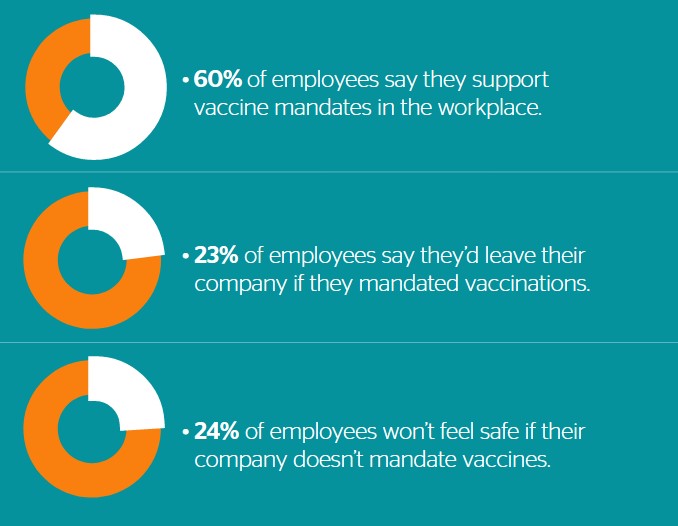Employer Challenges of Paying for COVID-19 Testing
Employers from all industries have been concerned about the COVID-19 pandemic. As new strains of the virus develop with varying transmission rates, many employers are scrambling to comply with COVID-19 prevention legislation in order to keep their workers safe. The Occupational Safety and Health Administration (OSHA) published an emergency temporary standard (ETS) covering COVID-19 safety standards for businesses to implement in their workplaces, in addition to other agency rules.
Employers must take certain things into account when paying for COVID-19 testing on a weekly basis as a result of these requirements. Employers paying for COVID-19 testing for their employees may have certain advantages and disadvantages, according to this study.
OSHA ETS Overview
On Nov. 4, 2021, OSHA announced a COVID-19 vaccination and testing ETS to address the grave danger of COVID-19 infection in the workplace. The ETS affects private sector employers with 100 or more employees. At this time, the OSHA ETS is in effect, but that could change due to the fluidity of litigation and the ruling of the Supreme Court of the United States. Employers should monitor the situation closely to know what the requirements are.
The ETS requires employers to implement and enforce a mandatory COVID-19 vaccination policy; or create a policy requiring employees to either get vaccinated or wear a face covering in the workplace and have weekly COVID-19 testing done.
Employees who are not fully vaccinated must be tested weekly or within seven days before returning to work. Acceptable COVID-19 tests under the ETS are those approved by the Federal Drug Administration (FDA), administered in accordance with the authorized instructions, and not both self-administered and self-read unless observed by the employer or a telehealth proctor. Under the ETS, employers must also maintain a record of each test result provided by their employees or obtained during workplace testing.
The ETS does not require employers to pay for any costs associated with testing. However, employer payment for testing may be required by other laws or other collectively negotiated agreements.
Employers are also required to allow reasonable time—including up to four hours of paid time—to receive a primary vaccination dose. Reasonable time and paid sick leave are also required to recover from any side effects of the vaccination.
Under the Fair Labor Standards Act (FLSA), employers are required to pay employees for any time spent waiting for and receiving medical attention required by their direction. However, it has been questioned whether COVID-19 screening is considered medical attention. Employers should reach out to legal counsel in their respective states to determine their specific requirements.
 Benefits of Paying for Testing
Benefits of Paying for Testing
There are several reasons employers may want to cover the costs of COVID-19 tests for their employees. First, doing so can allow employers to perform the testing on-site and control the length of time their employees are off work to obtain testing.
It’s also important to note that it can be costly for employees to pay for weekly testing. As such, employees who have to cover their own testing costs may eventually seek other employment to reduce their personal expenses. With this in mind, paying for COVID-19 testing may help employers better retain their workforce.
Employers can create fewer hassles for their employees by paying for and providing testing within the workplace. This way, when the tests are completed, they are read by employers, and employees don’t need to find a telehealth proctor or go to the doctor to be tested or confirm their test results.
Challenges With Paying for Testing
Employers with a low percentage of vaccinated employees may face issues finding enough tests to complete weekly testing. In certain areas, there are shortages of COVID-19 tests. If a shortage continues, it will pose a detriment to employers because the requirement for weekly testing will continue until employees decide to be fully vaccinated or until the ETS is no longer in effect.
In addition, testing costs may be significant, depending on demand. If tests are hard to come by, their associated prices will increase, which could cause financial issues for employers if they have to administer a large number of tests weekly. Even large employers may have financial issues if most of their workforce has to be tested weekly. This may pose significant strains on employers if they did not budget for testing, or worse—do not have the workforce to continue generating revenue.
Another issue employers may encounter from paying for and providing tests to employees is finding individuals to administer or witness these tests. This creates additional job tasks that have to be filled with employees spending time away from their other responsibilities. Otherwise, if employers don’t have employees available to conduct tests, they may have to create entirely new positions to oversee the completion of tests and handle the recordkeeping requirements related to employees’ vaccination statuses and weekly testing records.
Reviewing Policies and Applicable Laws
Employers should review federal, state, and local laws to determine the specific testing requirements for their respective businesses. In addition, if employers make workplace policies or procedures for these requirements, these expectations should be explicitly announced to their employees, well documented and followed consistently to prevent any legal challenges.
Conclusion
Ultimately, there are many factors employers must consider when it comes to paying for employee COVID-19 testing. To determine whether they should do so, employers should:
- Weigh the pros and cons of paying for testing for their employees
- Refer to any applicable laws to determine what their requirements are
- Make the decision based on what will work best for their workplace
Contact Metro Insurance Services today for additional COVID-19 guidance and OSHA resources.